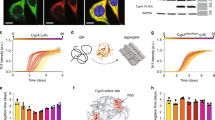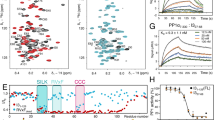Abstract
Cyclophilins constitute a ubiquitous protein family whose functions include protein folding, transport and signaling. They possess both sequence-specific binding and proline cis-trans isomerase activities, as exemplified by the interaction between cyclophilin A (CypA) and the HIV-1 CA protein. Here, we report crystal structures of CypA in complex with HIV-1 CA protein variants that bind preferentially with the substrate proline residue in either the cis or the trans conformation. Cis- and trans-Pro substrates are accommodated within the enzyme active site by rearrangement of their N-terminal residues and with minimal distortions in the path of the main chain. CypA Arg55 guanidinium group probably facilitates catalysis by anchoring the substrate proline oxygen and stabilizing sp3 hybridization of the proline nitrogen in the transition state.
This is a preview of subscription content, access via your institution
Access options
Subscribe to this journal
Receive 12 print issues and online access
$189.00 per year
only $15.75 per issue
Buy this article
- Purchase on Springer Link
- Instant access to full article PDF
Prices may be subject to local taxes which are calculated during checkout




Similar content being viewed by others
Change history
12 May 2003
footnote in HTML, errata last page of AOP PDF
Notes
Note: In the version of this article initially published online, the sequence for the model tetrapeptide substrate contains a mistake. This incorrect sequence is listed in two places, on page 4 line 21 and line 25 of the right hand column. The correct sequence should be Suc-Ala-Phe-Pro-Phe-NA. This mistake has been corrected for the HTML and print versions of the article.
References
Fischer, G., Whittmann-Liebold, B., Lang, K., Kiefhaber, T. & Schmid, F.X. Cyclophilin and peptidyl-prolyl cis-trans isomerase are probably identical proteins. Nature 337, 476–478 (1989).
Takahashi, N., Hayano, T. & Suzuki, M. Peptidyl-prolyl cis-trans isomerase is the cyclosporin A–binding protein cyclophilin. Nature 337, 473–475 (1989).
Schmid, F.X., Mayr, L.M., Mücke, M. & Schönbrunner, E.R. Prolyl isomerases: role in protein folding. Adv. Protein Chem. 44, 25–66 (1993).
Kern, G., Kern, D., Schmid, F.X. & Fischer, G. A kinetic analysis of the folding of human carbonic anhydrase II and its catalysis by cyclophilin. J. Biol. Chem. 270, 740–745 (1995).
Kern, D., Kern, G., Scherer, G., Fischer, G. & Drakenberg, T. Kinetic analysis of cyclophilin-catalyzed prolyl cis/trans isomerization by dynamic NMR spectroscopy. Biochemistry 34, 13594–13602 (1995).
Gothel, S.F. & Marahiel, M.A. Peptidyl-prolyl cis-trans isomerases, a superfamily of ubiquitous folding catalysts. Cell. Mol. Life Sci. 55, 423–436 (1999).
Luban, J., Bossolt, K.L., Franke, E.K., Kalpana, G.V. & Goff, S.P. Human immunodeficiency virus type 1 gag protein binds to cyclophilins A and B. Cell 73, 1067–1078 (1993).
Franke, E.K., Yuan, H.E.H. & Luban, J. Specific incorporation of cyclophilin A into HIV-1 virions. Nature 372, 359–362 (1994).
Thali, M. et al. Functional association of cyclophilin A with HIV-1 virions. Nature 372, 363–365 (1994).
Braaten, D., Franke, E.K. & Luban, J. Cyclophilin A is required for the replication of group M human immunodeficiency virus type 1 (HIV-1) and simian immunodeficiency virus SIVCPZ GAB but not group O HIV-1 or other primate immunodeficiency viruses. J. Virol. 70, 4220–4227 (1996).
Wiegers, K. & Kräusslich, H.-G. Differential dependence of the infectivity of HIV-1 group O isolates on the cellular protein cyclophilin A. Virology 294, 289–295 (2002).
Saphire, A.C., Bobardt, M.D. & Gallay, P.A. Trans-complementation rescue of cyclophilin A-deficient viruses reveals that the requirement for cyclophilin A in human immunodeficiency virus type 1 replication is independent of its isomerase activity. J. Virol. 76, 2255–2262 (2002).
Bosco, D.A., Eisenmesser, E.Z., Pochapsky, S., Sundquist, W.I. & Kern, D. Catalysis of cis/trans isomerization in native HIV-1 capsid by human cyclophilin A. Proc. Natl. Acad. Sci. USA 99, 5247–5252 (2002).
Brazin, K.N., Mallis, R.J., Fulton, D.B. & Andreotti, A.H. Regulation of the tyrosine kinase Itk by the peptidyl-prolyl isomerase cyclophilin A. Proc. Natl. Acad. Sci. USA 99, 1899–1904 (2002).
Arévalo-Rodríguez, M., Cardenas, M.E., Wu, X., Hanes, S.D. & Heitman, J. Cyclophilin A and Ess1 interact with and regulate silencing by the Sin3–Rpd3 histone deacetylase. EMBO J. 19, 3739–3749 (2000).
Schmid, F.X. Prolyl isomerases. Adv. Prot. Chem. 59, 243–282 (2002).
Gamble, T.R. et al. Crystal structure of human cyclophilin A bound to the amino- terminal domain of HIV-1 capsid. Cell 87, 1285–1294 (1996).
Yoo, S. et al. Molecular recognition in the HIV-1 capsid/cyclophilin A complex. J. Mol. Biol. 269, 780–795 (1997).
Zhao, Y., Chen, Y., Schutkowski, M., Fischer, G. & Ke, H. Cyclophilin A complexed with a fragment of HIV-1 gag protein: insights into HIV-1 infectious activity. Structure 5, 139–146 (1997).
Vajdos, F., Yoo, S.-H., Houseweart, M., Sundquist, W.I. & Hill, C.P. Crystal structure of cyclophilin A complexed with a binding site peptide from the HIV-1 capsid protein. Protein Sci. 6, 2297–2307 (1997).
Kallen, J. et al. Structure of human cyclophilin and its binding site for cyclosporin A determined by X-ray crystallography and NMR spectroscopy. Nature 353, 276–279 (1991).
Ke, H., Mayrose, D. & Cao, W. Crystal structure of cyclophilin A complexed with substrate Ala-Pro suggests a solvent-assisted mechanism of cis-trans isomerization. Proc. Natl. Acad. Sci. USA 90, 3324–3328 (1993).
Zhao, Y. & Ke, H. Crystal structure implies that cyclophilin predominantly catalyzes the trans to cis isomerization. Biochemistry 35, 7356–7361 (1996).
Zhao, Y. & Ke, H. Mechanistic implications of crystal structures of the cyclophilin–dipeptide complexes. Biochemistry 35, 7362–7368 (1996).
Eisenmesser, E.Z., Bosco, D.A., Akke, M. & Kern, D. Enzyme dynamics during catalysis. Science 295, 1520–1523 (2002).
Gitti, R.K. et al. Structure of the amino-terminal core domain of the HIV-1 capsid protein. Science 273, 231–235 (1996).
Vitagliano, L., Berisio, R., Mastrangelo, A., Mazzarella, L. & Zagari, A. Preferred proline puckerings in cis and trans peptide groups: implications for collagen stability. Protein Sci. 10, 2627–2632 (2001).
Zydowsky, L.D. et al. Active site mutants of human cyclophilin A separate peptidyl-prolyl isomerase activity from cyclosporin A binding and calcineurin inhibition. Protein Sci. 1, 1092–1099 (1992).
Stein, R.L. Mechanism of enzymatic and nonenzymatic prolyl cis-trans isomerization. Adv. Protein Chem. 44, 1–24 (1993).
Fischer, S., Michnick, S. & Karplus, M. A mechanism for rotamase catalysis by the FK506 binding protein (FKBP). Biochemistry 32, 13830–13837 (1993).
Hur, S. & Bruice, T.C. The mechanism of cis-trans isomerization of prolyl peptides by cyclophilin. J. Am. Chem. Soc. 124, 7303–7313 (2002).
Otwinowski, Z. & Minor, W. Processing of X-ray diffraction data collected in oscillation mode. Methods Enzymol. 276, 307–326 (1997).
Leslie, A.G.W. Joint CCP4 and ESF-EACMB Newsletter on Protein Crystallography Vol. 26 (Daresbury Laboratory, Warrington, 1992).
Collaborative Computational Project, Number 4. CCP4 Suite: programs for protein crystallography. Acta Crystallogr. D 50, 760–763 (1994).
Brünger, A.T. X-PLOR Version 3.843: A System for X-ray Crystallography and NMR (Yale University, New Haven, Connecticut, 1996).
Jones, T.A., Zou, J.-Y., Cowan, S.W. & Kjeldgaard, M. Improved methods for building protein models in electron density maps and location of errors in these models. Acta Crystallogr. A 47, 110–119 (1991).
Lamzin, V.S. & Wilson, K.S. Automated building of solvent structure combined with standard restrained refinement. Methods Enzymol. 277, 269–305 (1997).
Murshudov, G.N., Vagin, A.A. & Dodson, E.J. Refinement of macromolecular structures by the maximum-likelihood method. Acta Crystallogr. D 53, 240–255 (1997).
Murshudov, G.N., Vagin, A.A., Lebedev, A., Wilson, K.S. & Dodson, E.J. Efficient anisotropic refinement of macromolecular structures using FFT. Acta Crysallogr. D 55, 247–255 (1999).
Kraulis, P.J. Molscript: a program to produce both detailed and schematic plots of protein structures. J. Appl. Crystallogr. 24, 946–950 (1991).
Merritt, E.A. & Bacon, D.J. Raster3D: photorealistic molecular graphics. Methods Enzymol. 277, 505–524 (1997).
Laskowski, R.A., MacArthur, M.W., Moss, D.S. & Thornton, J.M. PROCHECK: a program to check the stereochemical quality of protein structures. J. Appl. Crystallogr. 26, 283–291 (1993).
Morris, A.L., MacArthur, M.W., Hutchinson, E.G. & Thornton, J.M. Stereochemical quality of protein structure coordinates. Proteins 12, 345–364 (1992).
Acknowledgements
We thank D.R. Davis, S.L. Alam, T.E. Cheatham III and members of the Hill and Sundquist labs for comments on this manuscript; H. Ke for providing processed structure factor amplitudes for the CypA–tetrapeptide structure; H.L. Schubert for help with refinement; and G.N. Murshudov for modifying REFMAC5 to allow the refinement of peptide structures containing prolines with partial cis and partial trans conformations. Operations of the Advanced Light Source, National Synchrotron Light Source and Stanford Synchrotron Radiation Laboratory are supported by the U.S. Department of Energy, Office of Basic Energy Sciences, and by the National Institutes of Health. This work was supported by NIH grants to W.I.S. and C.P.H.
Author information
Authors and Affiliations
Corresponding authors
Ethics declarations
Competing interests
The authors declare no competing financial interests.
Rights and permissions
About this article
Cite this article
Howard, B., Vajdos, F., Li, S. et al. Structural insights into the catalytic mechanism of cyclophilin A. Nat Struct Mol Biol 10, 475–481 (2003). https://doi.org/10.1038/nsb927
Received:
Accepted:
Published:
Issue Date:
DOI: https://doi.org/10.1038/nsb927
This article is cited by
-
TRIM5α self-assembly and compartmentalization of the HIV-1 viral capsid
Nature Communications (2020)
-
19F NMR relaxation studies of fluorosubstituted tryptophans
Journal of Biomolecular NMR (2019)
-
Cyclophilin A enables specific HIV-1 Tat palmitoylation and accumulation in uninfected cells
Nature Communications (2018)
-
Structural basis of interaction between dimeric cyclophilin 1 and Myb1 transcription factor in Trichomonas vaginalis
Scientific Reports (2018)
-
Molecular insights into substrate recognition and catalytic mechanism of the chaperone and FKBP peptidyl-prolyl isomerase SlyD
BMC Biology (2016)



